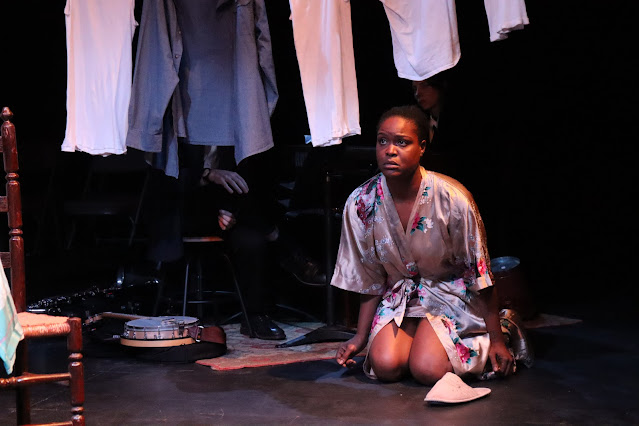Review: A More Concentrated and Contemporary "Six Characters in Search of an Author"
Six Characters in Search of an Author (Sei personaggi in cerca d'autore)
Written by Luigi Pirandello
Adapted and directed by Nick Gabriel
Presented at Casa Italiana Zerilli-Marimo’ at NYU (24 W 12th St., Manhattan, NYC), May 14, 2025, and NOoSPHERE Arts (520 Kingsland Avenue, Brooklyn, NYC), May 17, 2025
 |
| Sophia Chacon (center) in a previous production of Nick Gabriel's adaptation of Six Characters in Search of an Author. Photo by Edoardo Novello. |
Six Characters begins with a theater company rehearsing a Pirandello play; and the adaptation here, as elsewhere, pares down its original, quickly highlighting some of the themes of representation to come with one of the two actors (Sam Trott) questioning his costuming as a chef and discussing whether his beating of eggs is meant to have a metaphorical dimension. Shortly, the rehearsal is interrupted by the arrival of the eponymous characters: four onstage–Father (Feras Halabi), Mother (Isabella Kaplan), Stepdaughter (Sophia Chacon), and Son (Finn Mackimmie)–rather than six, with the family's young boy and little girl spoken of and later represented by a child's white dress, respectively. The adaptation also reduces the numerous members of the theater company in Pirandello's original text to the aforementioned two actors (Trott and Meridian Anastasia), the Director (Michael Reese Shald), and the Stage Manager (Kevin Wang), who do not immediately grasp that the characters who have entered the theater are just that, characters, fictional constructs whose author created but then abandoned them, leaving them to seek a work that they might inhabit in order to 'live.' The characters want this work to retell what 'really' happened among them, down to the exact words that they used; all of this was of course created by their erstwhile author but is, for them, immutable reality–more so, they point out, than existences and identities of living people, for whom today's reality may become tomorrow's illusion. At the center of the family's melodrama and remarriage and resentment is an incident in which the Father nearly purchased sex from his Stepdaughter, whom he supposedly did not recognize and who had been employed at a brothel masquerading as a hat shop. After this encounter is aborted by the Mother's intervention, the Father brings the Mother, the Stepdaughter, and the Mother's other two children (the Stepdaughter's siblings, all fathered by the same now-deceased man) back to his home, causing the Son, the child of the Father and the Mother before they separated decades ago, to feel displaced and ultimately leading to further tragedies which confront the audience as the characters try to convince the Director that they were "born for the stage."
The nature of the Father's transgression prompts the Director to declare that some things won't be tolerated on the stage, one of multiple threads about what it means to shape a story for the stage particularly or as art more generally. Like the Director thinks about shaping the story for a better reception, Gabriel's adaptation makes some tweaks that better situate the play within the current sociocultural atmosphere. The Father's creepiness towards the Stepdaughter, both during and after the incident in the hat shop is slightly lessened, while the Stepdaughter herself comes across as assertive and at times righteously angry, but as a rival to the Director rather than at any time a victim; and the hat shop/brothel is owned not by Pirandello's "monstrously fat harridan" Madam Pace (meaning "peace" in Italian) but by Ms. Modista (meaning, fittingly, "milliner" in Italian while perhaps also hinting at modishness), a change more in line with the adaptation's post-#metoo ethos. When the Stepdaughter makes a metatheatrical comment about not wanting to end up with a faithless adaptation of their story, Chacon delivers the line with a literal wink.
Appropriately for the play's metatheatrical character, a lot of dialogue is delivered to the audience, as if the rehearsal had been taking place in a full house; the cast, entering from the rear of the theater, make use of the area in front of the stage as well as a side aisle in which the Son, reluctant to join the proceedings, lingers for a time. The stage itself sports only a couple of benches, a stool, a chair, and a single floor lamp, but the distribution of the actors, most primarily in black, except for the bright white of the chef's whites worn by the two Actors, repeatedly creates visually interesting tableaux. As those Actors, Trott and Anastasia are very funny both in their unsuccessful representations of the Characters and as an onstage audience, as is Wang, reacting to the chaos around him as the Stage Manager and in his turn as Ms. Modista. Kaplan's tearful Mother, whose makeup is well designed to take advantage of that characteristic, has a standout moment of primal pain and grief during the production's expertly staged conclusion, while Shald brings the right amount of humorous pomposity to the Director and Mackimmie admirably generates sympathy for the Son, easy to dislike on the page. Halabi remains compelling as the Father whether he is sparring intellectually with the Director or reliving, yet again, his own shame, and Chacon is unfailingly assured and impressive as the Stepdaughter. This production of Gabriel's adaptation proves that the Characters may not have found a way to live, but Six Characters still has plenty of life in it.
-John R. Ziegler and Leah Richards
More from In Scena! 2025
News: In Scena! Italian Theater Festival NY Announces Venues and Performance Schedule for 2025 Festival
Review: "Alfredino" Taps into an Emotional Wellspring
Review: "In the Name of Mary" Sees Love Cut Short
Review: One Migrant Undergoes a Sea Change in "Lampedusa Beach"
Review: "The Popess" Looks Back to Spotlight Forward-Looking Women
Review: In "Pelle," the Beast *Is* Beauty
Review: "The Perky Theresas" Calls Up a Fond Remembrance of Aunts PastReview: "My Mama Notarizes & Also Makes Risotto" Tells–and Sings–a Story About Stories



Comments
Post a Comment